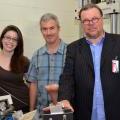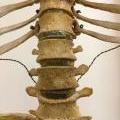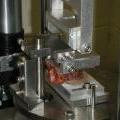The MUHC Orthopaedic Research Laboratory
If you were to wander through the old halls of the Royal Victoria Hospital of the McGill University Health Centre (MUHC), you might notice innumerable doors tucked away behind narrow corridors, each guarding its own unique secrets. But if you were to venture to the fourth floor of the Medical wing of the hospital, you might stumble upon the small passage that leads to the Orthopaedic Research Laboratory.
I met with Dr. Thomas Steffen, director of the Orthopaedic Research Laboratory, one afternoon in October as he and his team were preparing to test new equipment currently under development.
“We study the spine from a biological, a mechanical or engineering, and a medical or surgical standpoint,” said Dr. Steffen. “We are an interdisciplinary group of engineers, biologists and doctors working to find solutions to help people that have back pain or spinal illnesses.”
The nature of intervertebral discs
The focal point of Dr. Steffen’s research is intervertebral discs, which have one major function in the body: to act as a load-bearing mechanism that absorbs shocks from our daily activities, whether walking, running, lifting our own weight, or lifting objects. Discs are able to compress and rebound throughout the day, but with aging they also suffer from degeneration, which results in loss of elasticity and a reduction in the ability of the disc to act as shock absorber.
Unlike some other spine and bone research conducted at the MUHC, Dr. Steffen’s team develops tools and techniques that are brought to market within six months to three years, which is a fast turnaround in the medical device sector. “Our work definitely falls under the ‘applied’ category of research,” he added, smiling. “I like to think of myself as an ‘entrepreneur.’ I work as a researcher in this hospital, but I am also an entrepreneur. I recruited people, I built a research team, and I bring to market the devices we develop here. I don’t cost the health centre a thing—rather I bring money in.”
He soon led me to one of the many workspaces of the lab, where he showed me the 3D printer he uses to build artificial vertebral body models. “With this 3D printer, we create mechanical surrogates. This allows us to have control over the geometry of the vertebral body, and test how it will react to cement solutions, which is useful for testing treatments for osteoporosis, for example, without having to use biological materials each time.”
The 3D printer is also used to create an exact replica of a fractured vertebral body, taken from a scan of an affected spine. “In other words, we print the disease, so that we can hold in our hands the very problem that is afflicting the patient. We can then design a prosthetic to perfectly suit the situation.”
The workshop
Dr. Steffen asked me if I would like to see how they create the prostheses. This time we walked to a larger workshop, which was more reminiscent of a garage than a medical device laboratory: rows of tools hung from the walls, workbenches held devices to help fine-tune the equipment, and the loud humming of the machines in operation was unceasing. Yet the clear plastic bins on the ground that displayed polyurethane skeletons reminded me of the nature of the research being conducted.
“Right now we are doing some tests on an injector we hope to bring to market in the next year. This device allows a surgeon to inject cement into a vertebral body that is damaged because of osteoporotic weakness,” said Dr. Steffan. The injector, which looks much like a hand-held syringe, uses very viscous bone cement that requires high pressure to extrude. “There are other devices available that use mechanical advantage to push the cement into the patient’s bone, but they lack tactile feedback. Our device is hand-held, provides very high pressure and high accuracy and gives feedback more quickly and precisely to the surgeon.” Currently, the Orthopaedic Laboratory is conducting safety control tests to ensure that the device will be ready for future use.
Harvesting the human spine
At the end of my tour, Dr. Steffan explains the most interesting aspect of his research methodology: the harvesting of live human spines.
Every year in Montreal, about 35 people suffer medical conditions and enter comas that they will never wake from. When the decision is made to end critical care, and if these patients are organ donors, surgery is performed to remove a segment of their spine, which is then transported to a laboratory at the Montreal General Hospital. The spines are held in nutrient solutions that keep the discs alive for several weeks while under physiological loading conditions applied by a custom-built computer controlled loading machine.
“We are really interested in how age changes the spine, and to find out how to treat efficiently and at lower cost those patients with disc degeneration, which is why we set up this unique laboratory. We are able to conduct spinal research that, so far as I know, no one else has access to. For example, we also inject the discs with chemicals that create degeneration, which then allows us to test biological reparation techniques.”
When our interview comes to an end, I am left wondering if and when Dr. Steffen’s research will help me in my future health issues. As a man in his 30s, I know that my intervertebral discs may have already begun to show signs of degeneration. Will I join the one percent of Canadians that suffer from persistent back pain, and require one of the therapies being developed at the Orthopaedic Research Laboratory?
— Alessandro Masi




